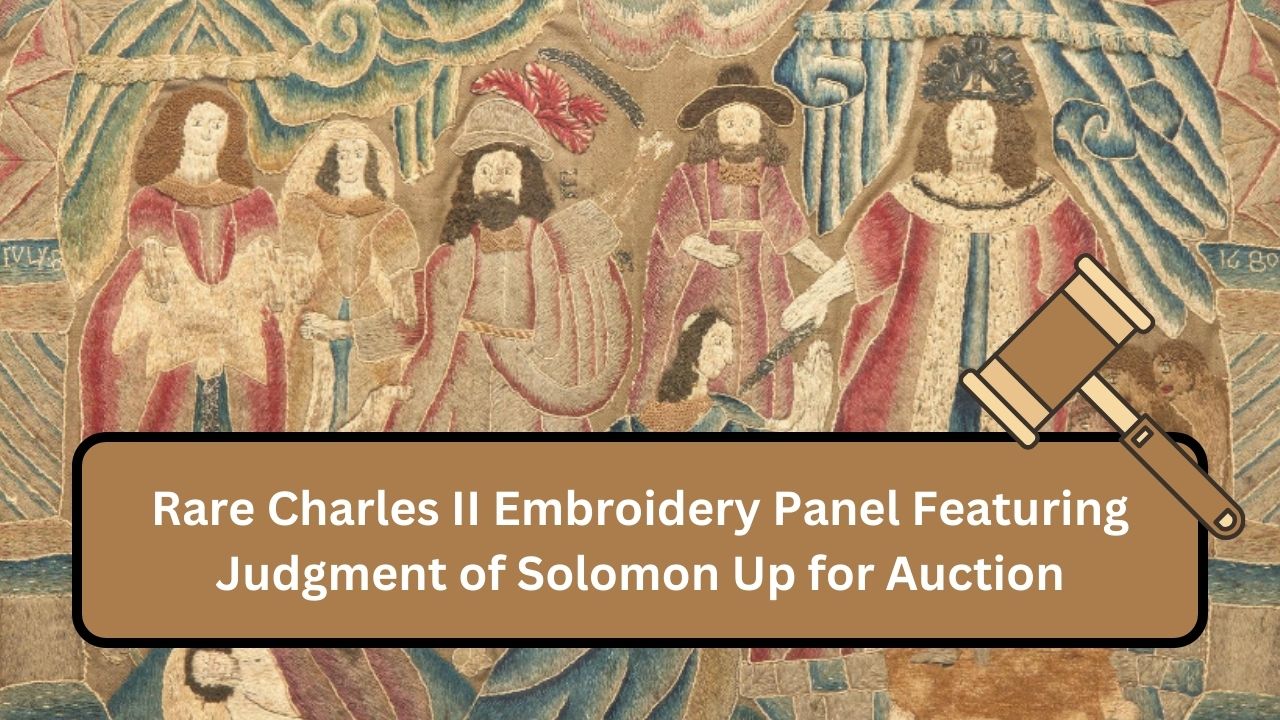Offering a window into the world of 17th-century English workmanship, the rare and stunning antique art item The Charles II Laid Work Embroidery Panel shows the Judgment of Solomon. Among collectors, this intricate work of art is not only a wonderful example of stitching but also a very valuable historical relic.
Projected value between $2,000 and $4,000; auction on January 27, 2025. Let’s examine closer the specifics of this work, including its background, relevance, and auction procedure.
What is a Laid Work Embroidery Panel?
Made work. In embroidery, a kind of needlework, threads are sewn in place and meticulously put over the fabric, usually in complex patterns. With metallic and silk threads utilized in the Charles II panel, the design gains even more richness and grace. Common in the 17th century, particularly in royal and aristocratic environments where art and workmanship were greatly prized, this needlework method was used extensively.
The Depiction of the Judgment of Solomon
This particular embroidered panel depicts the well-known biblical tale of wise King Solomon. Two ladies approaching the king in the Judgment of Solomon claimed to be mothers of children. Solomon suggested splitting the child in two, but the actual mother volunteered right away to give up her claim to preserve the infant’s life. The stitching captures this period of wisdom, so this work of art is not just a depiction of justice and fairness but also a meaningful one.
Historical Significance
Dating “July 8, 1680,” the Charles II Laid Work Embroidery Panel has great resonance with the reign of King Charles II of England, who presided over from 1660 until 1685. After a period of civil conflict, the monarchy was rebuilt and artistic expression grew in England throughout this age.
Rich families and the royal court commissioned many of the artworks from this period, which makes them priceless historical objects. The stitching is evidence of the social and cultural milieu of the time as much as a beautiful example of 17th-century textile art.
Auction Details
Starting at 10:00 AM EST on January 27, 2025 Freeman’s and Hindman will hold a live auction featuring this artwork. The auction will take place in Freeman’s New York, New York offices, 32 E 67th Street. Starting at $1,000, collectors as well as art aficionados should show great interest. The panel’s old frame adds further authenticity and historical value to the work.
Provenance of the Embroidery Panel
The embroidery has a fascinating provenance; it has belonged to eminent people. Originally bought on January 16, 1952, from Ginsburg & Levy Inc., in New York, Later owners were E. Ross (1894–1971) and Bessie S. Millhiser (1895–1987), from Richmond, Virginia; then Kenneth (1924–2021) and Katherine Millhiser (b. 1937) from Piedmont, California. The thorough background of the work accentuates its appeal since, in auctions, the value of art depends much on its origin.
Auction Process and Bidding
Should you be inclined to bid on the panel, you must register for the auction. Freeman’s offers safe online bidding; you can start your bids at $1,000. Bid increases will operate under a disciplined mechanism:
- Increases from $0 to $ 999 are $50.
- Increases from $1,000 to $1,399 are $100.
- From $2,000 to $4,999, increases run $250.
- Higher price ranges call for further increments.
Additional fees include buyer’s premium of up to 32% as well as any relevant taxes and shipping costs. Freeman’s does not offer direct packing and shipping services, however they do suggest reliable outside shippers to manage buyer logistics.
Shipping and Payment Details
You can pay for the embroidery panel by ACH, American Express, Visa, MasterCard, or even wire transfer once you bid on it. Freeman’s does not, however, give direct packing and shipping options, hence consumers have to make plans for these services using suggested outside vendors. Either faxing or emailing Freeman’s with the pertinent information will allow you to authorize the artwork release to the shipping firm in writing.
Property is to be taken off Freeman’s grounds seven business days after the auction ends. Any property left over this time will pay a $5 lot per day storage charge. Buyers should so make plans in line.
Why is this Piece Valuable?
The Charles II Laid Work Embroidery Panel is artistic and historical as well. Particularly from the years of Charles II, this is a unique specimen of English embroidery from the 17th century. While the biblical narrative gives the artwork depth and meaning, the careful use of silk and metallic threads shows the craftsmanship ability.
Moreover, the pedigree of the work and its relationship to well-known collectors give possible purchasers levels of authenticity and attraction.
Because of their link to a specific era or royal history, collectors may search for objects like these. This embroidered panel is a very sought-after item in the auction scene because of its rareness, historical relevance, and workmanship quality.
Ultimately, the Charles II Laid piece Embroidery Panel Depicting the Judgment of Solomon is a priceless historical relic as well as a piece of art. This work presents a special chance for art buyers because of its meticulous workmanship and link to England in the 17th century.
Taking place on January 27, 2025, the auction will let eager purchasers bid on a rare and important item of English history. Like many great works of art, the background, condition, and artistic quality define the worth and appeal of this must-see object for both collectors and history buffs.
You Must Visit :- Schott Auction Gallery

